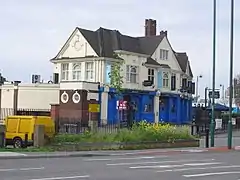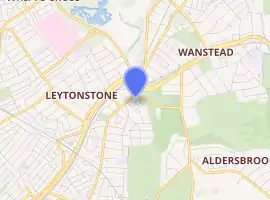Green Man, Leytonstone
The Green Man is a pub and road junction on High Road, Leytonstone, London. The pub has been rebranded as part of the O'Neill's chain. The current 1920s building replaced an earlier public house on the same site, built around 1668; it was mentioned by Daniel Defoe.
| Green Man | |
|---|---|
 The pub in 2008 | |

| |
| General information | |
| Type | Public house |
| Location | Leytonstone, London, England |
| Coordinates | 51°34′14″N 0°0′56″E |
| Construction started | 1668 |
Pub
There has been a pub at this location since around 1668.[1] On 22 August 1722, Christopher Layer and Stephen Lynch were arrested in the pub over a plot to assassinate King George I. A robbery by Dick Turpin reportedly took place outside the premises on 30 April 1737, when Turpin attacked Joseph Major and took his horse and around £7 to £8 in silver.[2][3]
The pub is named by Daniel Defoe in his account "Tour through the Eastern Counties of England", published as part of A tour thro' the whole island of Great Britain in 1724: "the great road passed up to Leytonstone, a place by some known now as much by the sign of the Green Man, formerly a lodge upon the edge of the forest".[4]
By the end of the 18th century, it had become the most important inn in the local area, as it sat on the main coaching road from London to Cambridge and Newmarket.[2] In the early 20th century, the pub included a room known as the "Dick Turpin chamber" and was reputed to be haunted.[1]
The current premises dates from the late 1920s.[2] The pub has been rebranded and is now trading as part of the O'Neill's chain.[5]
Road junction
.jpg.webp)
The junction is now a roundabout which connects the A12, a major road from London to Colchester, High Road, Leytonstone and Whipps Cross Road. There are a number of cycle lanes underneath the roundabout that provide access between Leytonstone town centre and Epping Forest.[6] London Buses route 257 runs through the junction and has a stop marked "Green Man Roundabout".[7]
The North Metropolitan Tramways Co constructed a tramway along High Road, Leytonstone, with the terminal junction at the Green Man opening in 1878.[8]
The original route of the North Circular Road, planned around 1916, ended at this junction.[9] The roundabout was constructed between 1963 and 1965;[10] the A12 underpass opened in 1999.[11]
References
- Roud, Steve (2012). London Lore: The legends and traditions of the world's most vibrant city. Random House. p. 277. ISBN 978-1-409-03619-7.
- "Leytonstone" (PDF). Leyton History Society. Retrieved 9 October 2019.
- Hagger, Nicholas (2012). A View of Epping Forest. John Hunt Publishing. p. 81. ISBN 978-1-846-94587-8.
- Defoe, Daniel (1724). A Tour Thro' the Whole Island of Great Britain, divided into circuits or journeys, vol.1.
- "O'Neill's Irish pub undergoes facelift to please Leytonstone's 'hip' newcomers". East London and West Essex Guardian. 4 April 2017. Retrieved 9 October 2019.
- Leytonstone Town Centre (PDF) (Report). London Borough of Waltham Forest. 16 February 2012. p. 2. Retrieved 9 October 2019.
- "Green Man Roundabout". Transport for London. Retrieved 9 October 2019.
- 'Leyton: Introduction', in A History of the County of Essex: Volume 6, ed. W R Powell (London, 1973), pp. 174-184. British History Online [accessed 9 October 2019]
- Smith, Denis (2001). London and the Thames Valley. Thomas Telford. p. 143. ISBN 978-0-727-72876-0.
- "London-Norwich-Trunk Road, A11/12: construction of roundabout at `Green Man', Leytonstone". National Archives. 1965. Retrieved 9 October 2019.
- "A12 – M11 Link Road Official Opening 6 October". wussu.com. Retrieved 28 December 2009.
External links
- Green Man, 762 High Road, Leytonstone – Pub Wiki
- Green Man Roundabout – SABRE